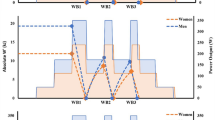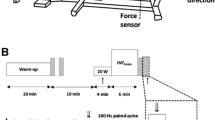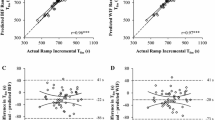Summary
The critical power (CP) of a muscle group or individual may represent the highest rate of work which can be performed for an extended period. We investigated this concept in young (n = 13, 24.5 years) and elderly (n = 12, 70.7 years) active men by first determining CP and then comparing responses elicited by 24 min of cycle exercise at power outputs (ω) corresponding to CP. Values from the final 2 min of the 24-min ride were expressed relative to maximal values established in a ramp test. CP for the elderly was only 65% that for the young, but on a relative basis, it was significantly higher both in terms of ω (67 vs 62% of ωmax) and oxygen consumption (\(\dot VO_2 \)) (91.5 vs 85.2% of maximum oxygen consumption). There were no group differences in relative values for ventilation (\(\dot V_E \)), heart rate or respiratory exchange ratio (R). During the 24-min ride,\(\dot VO_2 \) andR achieved a plateau in both groups, while\(\dot V_E \), blood lactate and arterialPCO2 continued to change in the young. It was concluded that CP can be determined in active elderly men, but that CP may not represent a true non-fatiguing work rate in either young or elderly men.
Similar content being viewed by others
References
Allen WK, Seals DR, Hurley BF, Ehsani AA, Hagberg JM (1985) Lactate threshold and distance-running performance in young and older endurance athletes. J Appl Physiol 58:1281–1284
Aunola S, Alanen E, Marniemi J (1990) The relation between cycling time to exhaustion and anaerobic threshold. Ergonomics 33:1027–1042
Beaver W, Lamarra N, Wasserman K (1981) Breath-by-breath measurement of true alveolar gas exchange. J Appl Physiol 51:1661–1675
Buskirk ER, Hodgson JL (1987) Age and aerobic power: the rate of change in men and women. Fed Proc 46:1824–1829
Calne DB, Eisen A, Meneilly G (1991) Normal aging of the nervous system. Ann Neurol 30:206–207
Carnevale TJ, Gaesser GA (1991) Effects of pedaling speed on the power-duration relationship for high-intensity exercise. Med Sci Sports Exerc 23:242–246
Chick TW, Cagle TG, Vegas FA, Poliner JK, Murata GH (1991) The effect of aging on submaximal exercise performance and recovery. J Gerontol 46:B34–38
Davis JA, Whipp BJ, Lamarra N, Huntsman DJ, Frank MH, Wasserman K (1982) Effect of ramp slope on measurement of aerobic parameters from the ramp exercise test. Med Sci Sports Exerc 14:339–343
Hagberg JM, Yerg JE, Seals DR (1988) Pulmonary function in young and older athletes and untrained men. J Appl Physiol 65:101–105
Housh DJ, Housh TJ, Bauge SM (1989) The accuracy of the critical power test for predicting time to exhaustion during cycle ergometry. Ergonomics 32:997–1004
Hughson RL, Orok CJ, Staudt LE (1984) A high velocity treadmill running test to assess endurance running performance. Int J Sports Med 5:23–25
Jones NL, Roberson DG, Kane JW (1979) Difference between end-tidal and arterialPCO2 in exercise. J Appl Physiol 47:954–960
Klitgaard H, Mantoni M, Schiaffino S, Ausoni S, Gorza I, Laurent-Winter C, Schnohr P, Saltin B (1990) Function, morphology and protein expression of ageing skeletal muscle: a crosssectional study of elderly men with different training backgrounds. Acta Physiol Scand 140:41–54
Lindinger MI, Sjogaard G (1991) Potassium regulation during exercise and recovery. Sports Med 11:382–401
Makrides L, Heigenhauser GJF, McCartney N, Jones NL (1985) Maximal short term exercise capacity in healthy subjects aged 15–70 years. Clin Sci 69:197–205
Mognoni P, Sirtori MD, Lorenzelli F, Cerretelli P (1990) Physiological responses during prolonged exercise at the power output corresponding to the blood lactate threshold. Eur J Appl Physiol 60:239–243
Monod H, Scherrer J (1965) The work capacity of a synergic muscle group. Ergonomics 8:329–338
Moritani T, Nagata A, deVries HA, Muro M (1981) Critical power as a measure of physical work capacity and anaerobic threshold. Ergonomics 24:339–350
Myers J, Walsh D, Sullivan M, Froelicher V (1990) Effect of sampling on variability and plateau in oxygen uptake. J Appl Physiol 68:404–410
Nakao M, Inoue Y, Murakami H (1989) Aging process of leg muscle endurance in males and females. Eur J Appl Physiol 59:209–214
Nebelsick-Gullett LJ, Housh TJ, Johnson GO, Bauge SM (1988) A comparison between methods of measuring anaerobic work capacity. Ergonomics 31:1413–1419
Noakes TD (1988) Implications of exercise testing for prediction of athletic performance: a contemporary perspective. Med Sci Sports Exerc 20:319–330
Noble BJ, Borg G, Jacobs I, Ceci R, Kaiser P (1983) A categoryratio perceived exertion scale: relationship to blood and muscle lactates and heart rate. Med Sci Sports Exerc 15:523–528
Overend TJ, Cunningham DA, Paterson DH, Smith WDF (1991) Critical power in young and elderly men. Can J Physiol Pharmacol 69: Axxiv-Axxv
Poole DC, Ward SA, Gardner GW, Whipp BJ (1988) Metabolic and respiratory profile of the upper limit for prolonged exercise in man. Ergonomics 31:1265–1279
Ribeiro JP, Hughes V, Fielding RA, Holden W, Evans W, Knuttgen HG (1986) Metabolic and ventilatory responses to steady state exercise relative to lactate thresholds. Eur J Appl Physiol 55:215–221
Rogers MA, Hagberg JM, Martin WH III, Ehsani AA, Holloszy JO (1990) Decline in\(\dot VO_{2max} \) with aging in master athletes and sedentary men. J Appl Physiol 68:2195–2199
Rowe JW, Kahn RL (1987) Human aging: usual and successful. Science 237:143–149
Rusko H, Luhtanen P, Rahkila P, Viitasalo J, Rehunen S, Harkonen M (1986) Muscle metabolism, blood lactate and oxygen uptake in steady state exercise at aerobic and anaerobic thresholds. Eur J Appl Physiol 55:181–186
Thomas SG, Cunningham DA, Thompson J, Rechnitzer PA (1985) Exercise training and ”ventilation threshold“ in elderly. J Appl Physiol 59:1472–1476
Thorland WG, Johnson GO, Cisar CJ, Housh TJ, Tharp GD (1987) Strength and anaerobic responses of elite young female sprint and distance runners. Med Sci Sports Exerc 19:56–61
Whipp BJ, Davis JA, Torres F, Wasserman K (1981) A test to determine parameters of aerobic function during exercise. J Appl Physiol 50:217–221
Young A, Stokes M, Crowe M (1985) The size and strength of the quadriceps muscles of old and young men. Klin Physiol 5:145–154
Author information
Authors and Affiliations
Rights and permissions
About this article
Cite this article
Overend, T.J., Cunningham, D.A., Paterson, D.H. et al. Physiological responses of young and elderly men to prolonged exercise at critical power. Europ. J. Appl. Physiol. 64, 187–193 (1992). https://doi.org/10.1007/BF00717959
Accepted:
Issue Date:
DOI: https://doi.org/10.1007/BF00717959




